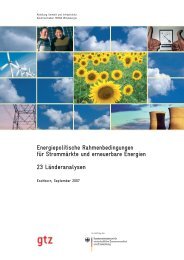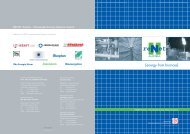K u rzfassu n g sb an d - Graz University of Technology
K u rzfassu n g sb an d - Graz University of Technology
K u rzfassu n g sb an d - Graz University of Technology
- Keine Tags gefunden...
Erfolgreiche ePaper selbst erstellen
Machen Sie aus Ihren PDF Publikationen ein blätterbares Flipbook mit unserer einzigartigen Google optimierten e-Paper Software.
172 Energieinnovation 2006<br />
Following the investigation <strong>of</strong> biomass policies, this paper provides a comparative survey about<br />
biomass potentials in central <strong>an</strong>d eastern Europe<strong>an</strong> countries as well as estimations for<br />
corresponding cost-resource-curves.<br />
By far the highest biomass potentials are available in Pol<strong>an</strong>d <strong>an</strong>d Germ<strong>an</strong>y (each in the r<strong>an</strong>ge <strong>of</strong> about<br />
500 to 700 PJ/yr. The lowest potentials show Slovenia <strong>an</strong>d Slovakia (each below 60 PJ/yr) <strong>an</strong>d<br />
Austria, Czech Republic <strong>an</strong>d Hungary are in the r<strong>an</strong>ge <strong>of</strong> about 100-250 PJ/yr.<br />
In Pol<strong>an</strong>d (<strong>an</strong>d also Hungary) agricultural products <strong>an</strong>d residues are dominating, the other countries<br />
show a mix <strong>of</strong> forestry <strong>an</strong>d agricultural potentials.<br />
In Czech Republic, the share <strong>of</strong> biomass on RES is currently 74%, in Austria about 50%. Hence, in<br />
both countries biomass plays a signific<strong>an</strong>t role in the structure <strong>of</strong> RES as a primary resource. The<br />
paper presents in detail the state <strong>of</strong> the art <strong>of</strong> biomass use in these countries.<br />
However, biomass market is still undeveloped in the Czech Republic <strong>an</strong>d has mainly local character.<br />
Biomass in the form <strong>of</strong> wood residuals from timber felling is expected to play import<strong>an</strong>t role in mid<br />
term. But in longer term the major role <strong>of</strong> intentionally pl<strong>an</strong>ted biomass is expected. The paper<br />
includes <strong>an</strong> investigation <strong>of</strong> the main barriers (like missing technological knowledge, legislation<br />
barriers, limitations by nature protection etc) for such innovative developments <strong>of</strong> the biomass market<br />
in CEE.<br />
The prospects <strong>of</strong> biomass use in the considered countries will be investigated. Partly, the existing<br />
policies will lead to a strong increase <strong>of</strong> biomass use. In Austria, in particular increased use <strong>of</strong> bi<strong>of</strong>uels,<br />
electricity generation from biomass <strong>an</strong>d pellets production is expected. According to the currently<br />
implemented quota for bi<strong>of</strong>uels, the bi<strong>of</strong>uel dem<strong>an</strong>d will increase from 50,000 t (2004) to about<br />
500,000 t in 2010. The electricity generation from biomass will increase from 0.3 TWh (2004) to 1.9<br />
TWh in 2007 <strong>an</strong>d pellet consumption will increase from less th<strong>an</strong> 4 PJ (2004) to about 9 PJ in 2010.<br />
Conclusions presented in this paper show that this dynamic development in some CEE countries<br />
could result in new challenges regarding the tr<strong>an</strong><strong>sb</strong>oundary biomass trade. Currently, in Czech<br />
Republic about 8% <strong>of</strong> total inl<strong>an</strong>d solid biomass production (incl. pulp extracts) is exported to abroad.<br />
Firewood was the most import<strong>an</strong>t part <strong>of</strong> export (44%), domin<strong>an</strong>t receiving countries were Austria<br />
(67%) <strong>an</strong>d Germ<strong>an</strong>y (17%). At least for some biomass fractions this trade <strong>of</strong> bi<strong>of</strong>uels could increase in<br />
the future. This <strong>of</strong> course will strongly be influenced by the development in different CEE countries,<br />
how biomass markets <strong>an</strong>d prices develop <strong>an</strong>d how biomass policies will be bal<strong>an</strong>ced between these<br />
countries.





